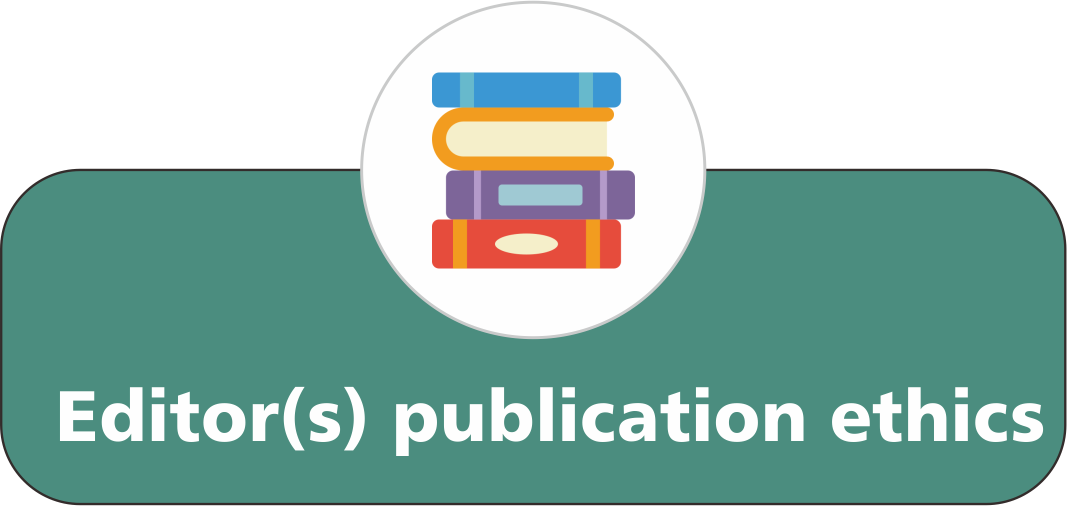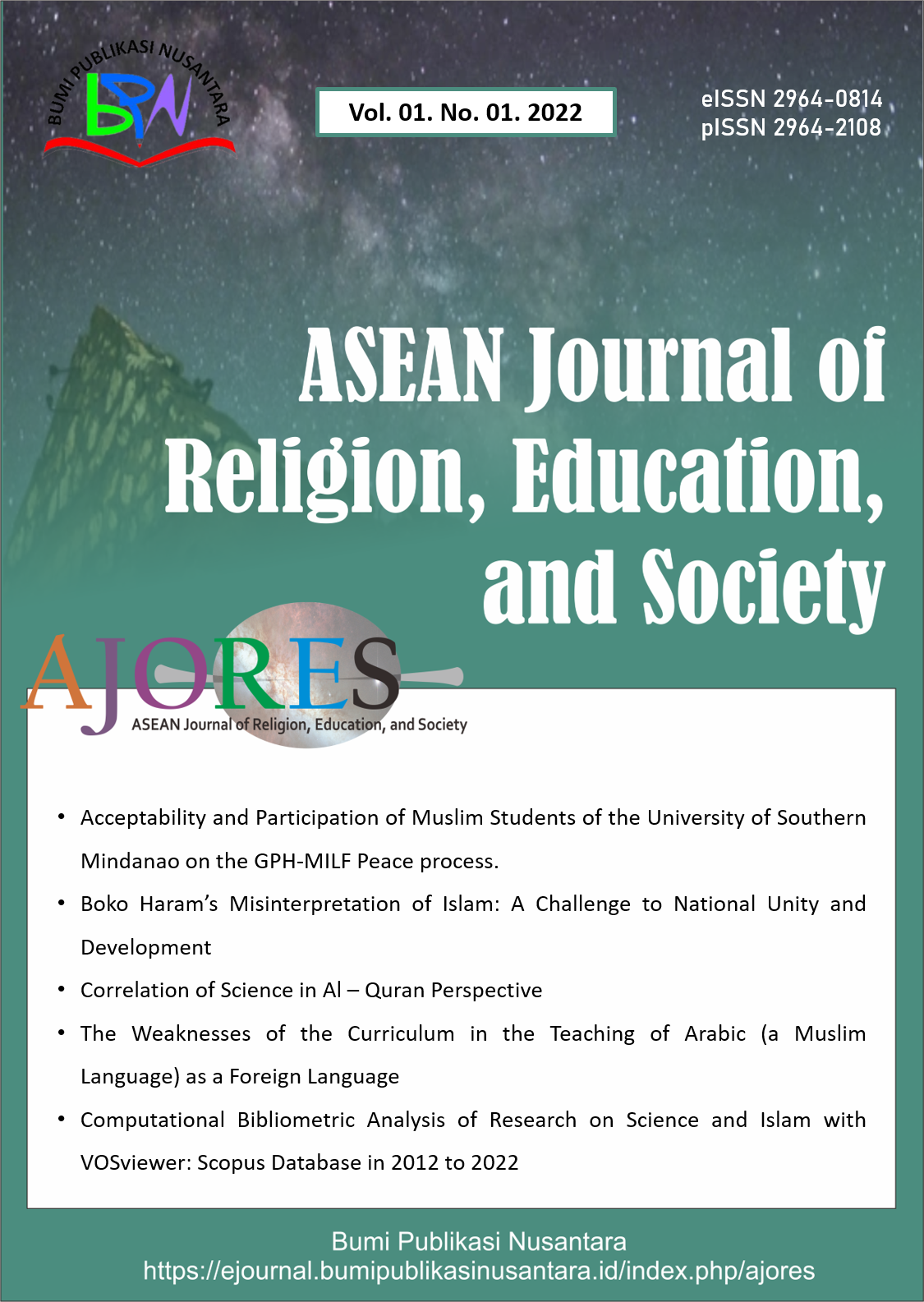From the Sky Versus to the Sky: Religion and the Endless Philosophical Feud
 ), Heri Gunawan(2),
), Heri Gunawan(2),
(1) Institut Agama Islam Negeri Syekh Nurjati
(2) Universitas Islam Negeri Sunan Gunung Djati
 Corresponding Author
Corresponding Author
Abstract
Keywords
References
Abusaada, H., and Elshater, A. (2024). Beyond keywords: Effective strategies for building consistent reference lists in scientific research. Publications, 12(3), 25.
Adeoye, M.A. (2023). Augustine and Cappadocian fathers' summation of the doctrine of the trinity: A theological perspective. ASEAN Journal of Religion, Education, and Society, 2(2), 59-66.
Ahmad, N., and Bakar, A.Y.A. (2023). Ecopsychology, restorativeness, spiritual values and emotional disturbances among undergraduates students: A systematic literature review. ASEAN Journal of Religion, Education, and Society, 2(2), 109-122.
Al Husaeni, D.F., and Munir, M. (2023). Literature review and bibliometric mapping analysis: Philosophy of science and technology education. Indonesian Journal of Multidiciplinary Research, 3(2), 219-234.
Anggraeni, R., and Maryanti, R. (2021). Implementation of video learning media in Islamic religious education subjects. Indonesian Journal of Multidiciplinary Research, 1(2), 257-266.
Aprison, W. (2017). Pandangan M. Quraish Shihab tentang posisi Alquran dalam pengembangan ilmu. Madania: Jurnal Kajian Keislaman, 21(2), 181-192.
Azhari, M.I. (2023). Theory and practice of state administrative law. Riwayat: Educational Journal of History and Humanities, 6(3), 823-830.
Azizah, S.N., Nandiyanto, A.B.D., Wulandary, V., and Irawan, A.R. (2022). Implementation of video learning media in Islamic religious education subjects for elementary school students. Indonesian Journal of Multidiciplinary Research, 2(1), 91-96.
Bassiouni, M.C., and Badr, G.M. (2001). The shari'ah: Sources, interpretation, and rule-making. UCLA J. Islamic and Near EL, 1, 135.
Bell, D. (1977). The return of the sacred? The argument on the future of religion. British Journal of Sociology, 28(4), 419-449.
Bergin, A.E. (1980). Psychotherapy and religious values. Journal of Consulting and Clinical Psychology, 48(1), 95.
Chano, J., Tungtawee, C., and Luo, M. (2023). Correlation between meditation and Buddhism: Bibliometric analysis. ASEAN Journal of Religion, Education, and Society, 2(2), 139-148.
Chano, J., Tungtawee, C., and Luo, M. (2024). Correlation between meditation and religion: Bibliometric analysis. ASEAN Journal of Religion, Education, and Society, 3(1), 11-22.
Chi, M.T. (1997). Quantifying qualitative analyses of verbal data: A practical guide. The Journal of The Learning Sciences, 6(3), 271-315.
Darke, P., Shanks, G., and Broadbent, M. (1998). Successfully completing case study research: Combining rigour, relevance and pragmatism. Information Systems Journal, 8(4), 273-289.
Davies, P. (1983). The edge of infinity. Ciel et Terre, 99, 65.
Durkheim, E. (2005). The dualism of human nature and its social conditions. Durkheimian Studies, 11(1), 35-45.
Dworkin, R. (1996). Objectivity and truth: You'd better believe it. Philosophy and Public Affairs, 25(2), 87-139.
Fadel, M. (2008). The true, the good and the reasonable: The theological and ethical roots of public reason in Islamic law. Canadian Journal of Law and Jurisprudence, 21(1), 5-69.
Ferriss, A.L. (2002). Religion and the quality of life. Journal of Happiness Studies, 3(3), 199-215.
Habermas, J. (2006). Religion in the public sphere. European Journal of Philosophy, 14(1).
Hart, T. (1998). Inspiration: Exploring the experience and its meaning. Journal of Humanistic Psychology, 38(3), 7-35.
Hidayat, T., Perdana, J., Istianah, I., Saputra, A., Erlina, L., Saket, S.A.S., Al-Gumaei, A.M.A. (2024). Social media da'wah strategy in implementing Islamic da'wah. ASEAN Journal of Religion, Education, and Society, 3(1), 51-58.
Horton, R. (1960). A definition of religion, and its uses. The journal of The Royal Anthropological Institute of Great Britain And Ireland, 90(2), 201-226.
Houston, S., and Stuart, D. (1996). Of gods, glyphs and kings: divinity and rulership among the Classic Maya. Antiquity, 70(268), 289-312.
Hribal, J. (2003). “Animals are part of the working class”: A challenge to labor history. Labor History, 44(4), 435-453.
Husaeni, M.F. (2023). Critical literature review on moral education system in Indonesia: How Islamic education and pancasila education monopolize morality in schools. Muslim Education Review, 2(1), 65-98.
John, D. (2010). Paul Davies and the philosophy of science. Journal of the International Society of Christian Apologetics, 3(1), 67-81.
Karmaker, R., and Rahman, R. (2024). Female having education in the world of technology wading obstacle facing religious and social barrier. ASEAN Journal of Religion, Education, and Society, 3(1), 23-36.
Kayode, A.M., and Jibril, A.O. (2023). Impact of traditional qur'anic schools on Islamic education. ASEAN Journal of Religion, Education, and Society, 2(2), 101-108.
Kelabur, A.A.S. (2024). Allah sebagai the wholeness: Relasi integral iman katolik dan sains modern menurut Ilia Delio. Dekonstruksi, 10(2), 6-23.
Khushvaktovna, B.Z., and Fayzievna, H.M. (2023). Affiliation motive as a factor in the health of the socio-spiritual environment in the family. ASEAN Journal of Religion, Education, and Society, 2(2), 83-100.
Landis, J.M. (1926). Constitutional limitations on the congressional power of investigation. Harvard Law Review, 40(2), 153-221.
Laughery, G.J., and Diepstra, G.R. (2006). Scripture, science and hermeneutics. European Journal of Theology, 15(1), 35.
Llewellyn, K.N., Adler, M.J., and Cook, W.W. (1931). "Law and the modern mind": A symposium. Columbia Law Review, 31(1), 82-115.
Maldonado-Torres, N. (2007). On the coloniality of being: Contributions to the development of a concept. Cultural Studies, 21(2-3), 240-270.
Mamirjonovna, M.M. (2024). Mechanism of development of students' spiritual development following professional training. ASEAN Journal of Religion, Education, and Society, 3(1), 1-10.
Margaret, C. (2022). Makna spiritual atau makna literal?. Te Deum (Jurnal Teologi Dan Pengembangan Pelayanan), 11(2), 163-194.
McCullough, M.E., and Willoughby, B.L. (2009). Religion, self-regulation, and self-control: Associations, explanations, and implications. Psychological Bulletin, 135(1), 69.
Monteiro, N.P., and Ruby, K.G. (2009). IR and the false promise of philosophical foundations. International Theory, 1(1), 15-48.
Moon, K., and Blackman, D. (2014). A guide to understanding social science research for natural scientists. Conservation Biology, 28(5), 1167-1177.
Muhajarah, K., and Bariklana, M.N. (2021). Agama, ilmu pengetahuan dan filsafat. Jurnal Mu’allim, 3(1), 1-14.
Mulyadi, M. (2011). Penelitian kuantitatif dan kualitatif serta pemikiran dasar menggabungkannya. Jurnal Studi Komunikasi dan Media, 15(1), 128-137.
Muvid, M.B., and Kholis, N. (2024). Contribution of sufism trilogy in the formation of religious behavior: A proposed model. Cogito, 16(1), 29-53.
Neville, R.C. (1995). Religions, philosophies, and philosophy of religion. International Journal for Philosophy of Religion, 38, 165-181.
O'Connell, J.T., and O'Connell, K.M. (2008). Introduction: Rabindranath tagore as ‘cultural icon’. University of Toronto Quarterly, 77(4), 961-970.
Petersen, F. (2023). Montesquieu and the concept of the non-arbitrary state. The European Legacy, 28(1), 25-43.
Polanyi, M. (1962). Tacit knowing: Its bearing on some problems of philosophy. Reviews Of Modern Physics, 34(4), 601.
Ritonga, R.S. (2022). Hubungan filsafat dan agama. Relinesia: Jurnal Kajian Agama dan Multikulturalisme Indonesia, 1(2), 16-22.
Romdhoni, A. (2015). Tradisi hafalan qur’an di masyarakat muslim Indonesia. Quran and Hadith Studies, 4(1), 1.
Saadu, U.T., Obafemi, K.E., and Adeyemi, C.O. (2023). Female genital mutilation: Parental perception and religious point of view. ASEAN Journal of Religion, Education, and Society, 2(2), 75-82.
Sanni, A.M. (2023). ICT tools for teaching the Arabic language. ASEAN Journal of Religion, Education, and Society, 2(2), 67-74.
Seferta, Y.H. (1985). The doctrine of prophethood in the writings of Muḥammad'Abduh and Rashīd Riḍā. Islamic Studies, 24(2), 139-165.
Selvia, N.L. (2024). Konsep pengembangan ilmu menurut imam Al-Ghazali: Perspektif epistemologi dan eksplorasi kontemporer. SERUMPUN: Journal of Education, Politic, and Social Humaniora, 2(1), 8-23.
Situngkir, S., Salis, M.I., and Aqila, K.T. (2024). Effect of religion, gender, and overconfident interactions on investment decisions tiar lina. ASEAN Journal of Religion, Education, and Society, 3(1), 37-50.
Smail, D. (2005). In the grip of sacred history. The American Historical Review, 110(5), 1337-1361.
StANOVčIć, V. (2013). Montesquieu, rousseau and the French revolution. The Review of International Affairs, 64(1151), 7-45.
Sunarto, S. (2016). Prinsip checks and balances dalam sistem ketatanegaraan indonesia. Masalah-Masalah Hukum, 45(2), 157-163.
Tabrani, Z.A. (2013). Modernisasi Pengembangan Pendidikan Islam (Suatu Telaah Epistemologi Pendidikan). Serambi Tarbawi, 1(1), 65-84.
Tamrin, A. (2019). Relasi ilmu, filsafat dan agama dalam dimensi filsafat ilmu. SALAM: Jurnal Sosial Dan Budaya Syar-I, 6(1), 71-96.
Teske, J.K. (2013). The methodology of art (critical/rationalist aesthetics): Project of a new philosophical discipline. Roczniki Humanistyczne, 61(5), 311-329.
Vásquez, M.A. (2008). Studying Religion in Motion: A Networks Approach. Method and Theory in the Study of Religion, 20(2), 151-184.
Völker, F. (2022). Methodology and mysticism: For an integral study of religion. Religions, 13(2), 161.
White Jr, L. (1967). The historical roots of our ecologic crisis. Science, 155(3767), 1203-1207.
Wilson, D.B. (1999). Galileo’s religion versus the church’s science? Rethinking the history of science and religion. Physics in Perspective, 1, 65-84.
Wilson, E.O. (1980). The relation of science to theology. Zygon: Journal of Religion and Science, 15(4), 425-434.
Zhang, Y., and Wildemuth, B.M. (2009). Qualitative analysis of content. Applications of Social Research Methods to Questions in Information and Library Science, 308(319), 1-12.
Article Metrics
Abstract View : 194 times
: 194 times Download : 130 times
Download : 130 times
Refbacks
- There are currently no refbacks.
Copyright (c) 2024 Bumi Publikasi Nusantara

This work is licensed under a Creative Commons Attribution-ShareAlike 4.0 International License.







